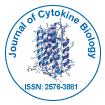Role of Innate Immunity
Received: 02-Oct-2002 / Editor assigned: 16-Oct-2021 / Accepted Date: 21-Oct-2016 / Published Date: 21-Oct-2021
Description
Description In addition, innate immunity is important in initiating the adaptive immune response. Natural killer cells and macrophages, among other innate immune cells, are critical in tumour surveillance and removal. In contrast to antigen-specific adaptive immunity, innate immune cells have spontaneous tumoricidal effects by releasing cytolytic granules or directly phagocytizing surrounding tumour cells. The importance and requirement of spatial closeness between activated effector cells and tumour cells in innate antitumor immunity is highlighted by these effects of innate immune cells. In insects, innate immunity is divided into two types: basal immunity, which regulates the production of effector molecules such as antimicrobial peptides on a continuous basis, and inducible immunity, which is activated in response to the detection of a pathogen or its product. Initial identification of pathogenic microorganisms is dependent on the innate immune system. Insects have an immune system that protects them from pathogenic bacteria that would otherwise put their lives in jeopardy. Immune processes can deal directly with pathogens by removing them from the host organism, or they can disarm them by inhibiting the production of poisons and virulence factors that enhance the intruder's invasion and destructive action within the host. Insects have established themselves as excellent models for researching immune system modulation because innate immunity may be studied at the whole-organism level. The latest genetic studies reveal pathways crucial to innate immunity, which we discuss here. Several genes formerly thought to be connected with recessive illnesses now exhibit dominant mutations, while others have both germline and somatic mutations, resulting in a wider range of symptoms. Variants in recognition and signalling in the population have a direct impact on infection susceptibility. Gamma herpesviruses are common diseases that infect the great majority of individuals around the world for the rest of their lives. Importantly, these viruses are linked to a variety of cancers and are responsible for a major portion of the human cancer burden. The capacity of gamma herpesviruses to successfully avoid the innate immune response throughout the course of infection contributes to these virus-associated malignancies. The anatomic and physiologic barriers, as well as the immune response system, make up the human microbial defence system in its most basic form. Adaptive immunity and innate immunity are the two branches of immunity that have historically been separated.T cells and B cells make up adaptive immunity, and each lymphocyte has a particular and structurally distinct receptor. As a result of this process, a vast repertory of antigen receptors is generated, increasing the chances of encountering an antigen that binds to the specific lymphocyte receptor. However, the process of lymphocyte clonal growth takes 3 to 5 days, which could provide the pathogen ample time to do damage. Until a sufficient number of lymphocyte clones are created and differentiated into effector cells, innate immunity, which includes phagocytes, antimicrobial peptides, and the complement system, is a crucial first line of defence. Within minutes of pathogen exposure, the innate immune response system targets conserved microbial components shared by a vast range of pathogens, triggering an inflammatory response. The embryo's successful implantation into a receptive endometrium is critical for the creation of a viable pregnancy; yet recurrent implantation failure is a serious issue in assisted reproduction. The Toll-like receptors of the maternal innate immune system are important in sustaining immunity in the female reproductive tract, which is essential for fertility
Citation: Fregoso O (2021) Role of Innate Immunity. J Cytokine Biol 6:068.
Copyright: © 2021 Fregoso O. This is an open-access article distributed under the terms of the Creative Commons Attribution License, which permits unrestricted use, distribution, and reproduction in any medium, provided the original author and source are credited
Share This Article
Recommended Journals
Open Access Journals
Article Usage
- Total views: 1058
- [From(publication date): 0-2021 - Mar 31, 2025]
- Breakdown by view type
- HTML page views: 626
- PDF downloads: 432
